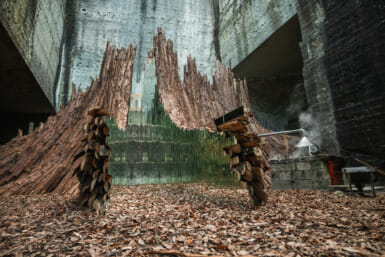by Eugene Kyle
Japan has lots of clay and it has lots of pottery. Bizen, Mashiko, Shigaryaki are all famous pottery towns, each with its own distinct style and tradition. Bizen is usually unglazed, while Shigaryaki has globs of white icing-like glaze. Mashiko is very workmanlike and is used in many Japanese restaurants.
My personal favorite is Hagiyaki, which comes form a small town at the far western end of honshu. It is famous for its light colors and a glaze that cracks and turns colors with use and age. Many years ago, when my children were small and we lived in Kobe, we took a three-day trip to Hagi.
In pottery towns you can usually find lots of pots; big, small, modern and traditional. If the town has a reputation, it will have pottery stores, lots of them. Hagi had lots. It then became a matter of finding out the difference between good and so-so.
During our wandering around Hagi, we discovered a distributor of the independent kilns. As I came to know, the industry breaks out along two lines. There are the factories which mass-produce by the cheapest method and then there are the artists who produce limited quantities in both the traditional and modern styles.
The pot shop we discovered only handled the latter and it was a little like walking into a museum, only all the pieces were originals.
The first night I walked in, I just sat and looked at the display. One wall of the store was made of black volcanic rock and various pieces had been arranged on the out-croppings the rock offered. There was a small bench for sitting. The owner’s wife gave me green tea and orange candies which were a specialty of Hagi. My children were small and a pottery shop was a high-risk danger area for us so we soon had to leave.
The next day I went back. This time the owner’s wife asked me if I would like to see their private collection. She took me into a small tatami room, separate from the shop, and, showed me beautiful teacups and other wonderful pots that were hundreds of years old. Each had a story. I only wished I could understand more. Suddenly, my young son started to cry and his mother called me away.
As I left, I bought one small teacup. The owner’s wife chose for me after I had initially picked the worst of the lot.
The next morning, our last, I went back as the shop opened. For the first time, the owner spoke to me. For two days he had stood in the background and only watched me. He had never spoken.
Now, he started to talk. In his hands was an unusual vase, rough-hewn like a traditional Japanese water bucket, not very much like Hagiyaki at all. He explained that Miwa Sensei, a potter designated as a national living treasure, had once visited Shigaryaki to study their pottery-making techniques. Upon his return, one of his apprentices had made the vase under his direction. It was beautiful.
The shop owner further explained that the pot leaked, so he couldn’t sell it. But, because he knew I loved pots, and especially Hagiyaki, he thought I might like to have it as a present. I didn’t know what to do. So, graciously as possible, I accepted.
Upon arriving home, a small piece of paper inside the vase explained that the clay of Hagiyaki is very porous so almost all Hagiyaki initially leaks. The man who loved pots wanted me to love them, too.
A few weeks ago, we moved. My vase was cracked. I was heartbroken. Then I realized the vase wasn’t so important to me, but the friendship and the memory of the man who loves pots is.








